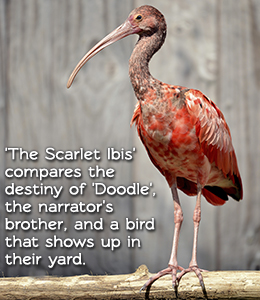I tried my hand at writing a short story once:
It was in the saddest of seasons, summer was dead but autumn had not yet been born, which meant school was about to start-oh, and the ibis lit in the bleeding tree. The flower garden next to Mr. NotPrepared’s portable was strained with rotting brown magnolia petals and ironweeds grew rank amid the purple ink that had spilled all over his “Scarlet Ibis” study guide, “Scarlet Ibis” lesson plans, “Scarlet Ibis” summary, and “Scarlet Ibis” analysis. The five o’clocks by the teacher desk still marked time, but the “Scarlet Ibis” lesson plan basket was untenanted and rocked back and forth like an empty administrator’s observation rubric.
I then realized it would just be easier to teach short stories and come up with awesome lesson plans, summaries, and more. This “Scarlet Ibis” study guide is just one of them.
“Scarlet Ibis” Summary

Doodle’s real name is William Armstrong and the narrator says he wanted to kill him because he was an invalid. At 2-years-old, William Armstrong learns to crawl and the narrator renames him Doodle. Doodle accompanies the narrator everywhere no matter how mean Brother is. The two like to kick it in Old Woman Swamp. Brother does some cruel things to Doodle, the most memorable occurring up in the barn loft where Brother forces Doodle to touch his own casket.
Doodle turns five but can’t walk. Brother is embarrassed and sets out to teach him. After several weeks of discouraging practice, Doodle stands on his own for a couple seconds. The two rejoice. On Doodle’s 6th birthday, October 8, Doodle walks. The family rejoices. They hug Doodle. They hug Brother for teaching him. Brother feels like a pile of dung because he realizes he taught Doodle to walk, not out of love, but out of the shame of having a crippled brother.

“Eudocimus Ruber Wading KL” by Bjørn Christian Tørrissen
(In basketball when a player hits several shots in a row, he often experiences what’s called a heat check and takes a shot that’s beyond his capabilities. The heat check usually ends in disaster-an air ball, a turnover, or the ball ricocheting off the side of the backboard and clanking the formerly on-fire hoopster in the privates.)
After Brother’s amazing success in getting Doodle to walk, he enacts the equivalent of a basketball heat check. He attempts to teach Doodle to run, swim, climb trees, and fight. The day of accomplishment is set for the end of the following summer, but progress lacks and the two fall behind schedule. Brother refuses to quit and works Doodle harder because he doesn’t want a brother who is “different.”
One day while at dinner, a noise is heard outside. The family runs out and a Scarlet Ibis falls from the bleeding tree, dead. Doodle buries the bird. Afterward, Doodle and Brother head to Horsehead Landing for more practice. After some hard rowing on the pond, Doodle collapses. They both realize their efforts have failed. Brother is angry and walks fast to get away from Doodle.
Brother, full of anger, runs and leaves Doodle behind. He begins to feel bad and waits for Doodle. Doodle never comes. The narrator goes back and finds Doodle beneath a bush sitting on the ground with his face buried in his arms. He moves Doodle’s head and notices blood from his mouth, on his neck, and on the front of his shirt.
Doodle is dead.
Make the Ibis come alive with this “Scarlet Ibis” teaching guide. It contains lesson plans aligned to common core objectives, graphic organizers and handouts with answer keys, grading rubrics, everything you see here (including my incredible charm and wit).
“Scarlet Ibis” Analysis
If you think this “Scarlet Ibis” summary is depressing, try reading the story. Here are some points for discussion.
- Imagery. Delightful imagery abounds in “The Scarlet Ibis.” Identify it. Discuss it. Analyze it.
- Symbolism. Symbolism abounds, the most obvious being “The Scarlet Ibis.” If a student doesn’t believe the Ibis is an important symbol, ask him in a condescending voice the following question: “Then why is it the title?” And then you can discuss the title with the rest of the class and every time someone gives an intelligent response, you can smirk at the student who didn’t believe you initially. On second thought, try to be more encouraging and positive.
- Mood and Word Choice. James Hurst’s vocabulary astounds. He uses it to establish the oppressive, depressing mood in “The Scarlet Ibis.”
- Plot. “The Scarlet Ibis” makes an excellent short story to teach the elements of plot. Although I try to provide top notch lesson ideas for my colleagues on the Internet, I’m not afraid to pass along other cool stuff, like this storyboard website I came across this morning.
- Themes. Themes in “The Scarlet Ibis” involve the effect of the natural world, the dangers of pride, the power of memories, the effects of guilt and blame.
Symbolism in “The Scarlet Ibis”
Before I throw out a free lesson plan with awesome graphic organizer, let’s discuss “The Scarlet Ibis” symbolism.
- The scarlet ibis. The bird symbolizes Doodle. There’s more about this in the “Scarlet Ibis” lesson plan that follows.
- The loft symbolizes confinement and restriction.
- The grindstone, a place where knives, axes, and other sharp objects are sharpened, symbolizes sacrifice (of Doodle and of innocence) and hard work.
- The clove of seasons is that time where everything begins to die. It’s a passage.
“The Scarlet Ibis” Lesson Plan.
I want to make sure every teacher that comes to this page looking for a “Scarlet Ibis” lesson plan has something he or she can use today. Let me know how I did.
We’ll start with those pesky objectives that your administrator thinks are so precious. We’ll word them in educatorese here. It’s good to have them handy so you can focus the lesson where it needs to go. If you’re going to write an objective on the board (sound teaching practice), pick one or more of these standards and reword it so students know what the heck they should be focused on. When I teach this lesson, here’s what I might write:
Find specific examples of symbolism in “The Scarlet Ibis,” explain the symbol, and analyze its effect on the overall theme, or meaning, of the story.
It takes a teacher to say in 25 words what it takes a lawyer, a politician, and a college professor sitting in their theory rooms to come up with in however many words are contained in the following Common Core Standards:
- RL 9-10.1 Cite strong and thorough textual evidence to support analysis of what the text says explicitly as well as inferences drawn from the text.
- RL 9-10.2 Determine a theme or central idea of a text and analyze in detail its development over the course of the text, including how it emerges and is shaped and refined by specific details; provide an objective summary of the text.
- RL 9-10.4 Determine the meaning of words and phrases as they are used in the text, including figurative and connotative meanings; analyze the cumulative impact of specific word choices on meaning and tone (e.g., how the language evokes a sense of time and place; how it sets a formal or informal tone).
- RL 11-12.3 Analyze the impact of the author’s choices regarding how to develop and relate elements of a story or drama (e.g., where a story is set, how the action is ordered, how the characters are introduced and developed).
Procedures
- Discuss symbolism
- Hand out this Scarlet Ibis Symbolism Chart. If you look at it before you hand it out, you’ll know exactly what to do. It’s self-explanatory. For more “Scarlet Ibis” lessons like this, click on the third bird. For great lessons for other short stories, follow the link.
- Sit back and accept the applause from an admiring student body and a raise from the school board for excellence in teaching that the union may or may not force you to not accept because it makes the mediocre teachers around you feel bad.
Last Updated on February 27, 2016 by Trenton Lorcher
Share This:
